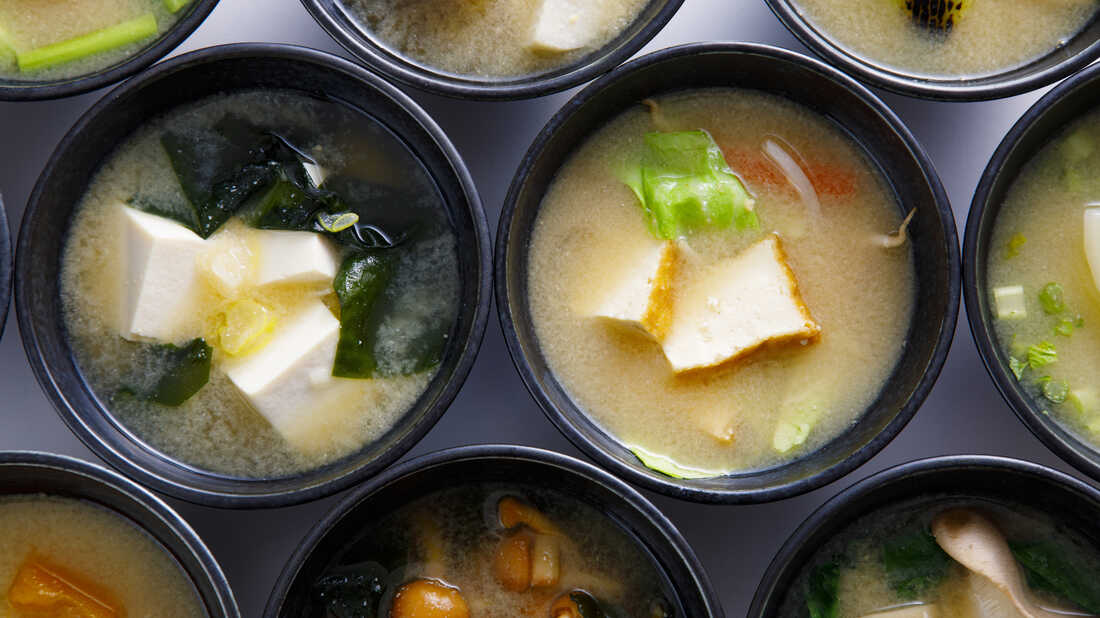

The wealthy savory taste of miso soup is one technique to expertise umami, the fifth main style.
Yuuji/Getty Pictures
conceal caption
toggle caption
Yuuji/Getty Pictures

The wealthy savory taste of miso soup is one technique to expertise umami, the fifth main style.
Yuuji/Getty Pictures
What makes a meal scrumptious? Usually, the reply could be umami. The Japanese phrase means “scrumptious style,” and refers particularly to a savory, meaty taste usually present in fish broths, mushrooms, cheese and tomato sauce.
Umami is now thought-about the fifth major style — subsequent to candy, bitter, bitter and salty, however as I found, umami has a personality and historical past all its personal.
Having Japanese immigrant mother and father meant I grew up consuming meals steeped in umami: Soy sauce, miso paste, and dashi, a broth made out of seaweed, shiitake mushrooms, or shaved bonito flakes, made out of dried tuna. These elements specifically are cornerstones of Japanese delicacies, so “umami” was a dinner-table phrase in my household, lengthy earlier than it entered the American lexicon.
I did not know what umami was, precisely; I considered it like a magical elixir, the culinary hero pumping up meals’s “yum issue.” It is savory and salty, like a ramen fabricated from long-simmered bone broth. It could even have tang, like marinara sauce sprinkled with Parmesan, or ranch-flavored tortilla chips. It appeared so central to describing deliciousness itself, it appeared odd that English would don’t have any equal phrase.
Then once more, I get why umami evades description. Nearly every little thing about it’s mysterious and sophisticated — from how we understand its style, to its historical past and its combat for legitimacy.
Oxford psychologist Charles Spence, who research style notion, says quite a lot of that most likely goes backs to the bizarre approach we sense umami. “It solely comes alive and it turns into scrumptious when it is mixed with an aroma,” he explains. That is not true of different tastes: “Sweetness is a candy whether or not or not you’ll be able to scent something; identical for salty, identical for bitter.”
By itself, umami does not style sturdy or notably good. However, says Spence, when mixed with different meals, umami punches up flavors of protein and salt, whereas additionally weaving in different tastes, like bitter and candy. “All of the tastes work together with each other, typically suppressing, typically enhancing the opposite tastes.”
This complexity of umami’s may additionally clarify why it wasn’t remoted and acknowledged as a style till comparatively not too long ago in Western tradition.
It was a Japanese man, impressed by his spouse’s wealthy kelp broth, who remoted the chemical compound glutamate from seaweed in 1908. Chemist Kikunae Ikeda, recognized it because the supply of this peculiar savory style, and referred to as it “umami.” (There are two different compounds – guanylate, and inosinate – that researchers additionally related to umami.)
However it might take practically a century — and the invention of glutamate receptors on our tongues 20 years in the past — earlier than Western cultures accepted umami as a major style.
That resistance, Spence says, is rooted in discrimination.
“[There are] racist undertones that it got here from the East,” he says, which meant Western scientists and cooks have been sluggish to embrace it. He says that legacy nonetheless powerfully shapes shopper notion at present.
Quickly after its discovery, a Japanese firm began advertising a salt-like additive that delivered an umami punch, monosodium glutamate, or the infamous MSG. That notoriety stems from a persistent, 50-year-old delusion that MSG utilized in Chinese language eating places causes complications.
“It is a zombie delusion that won’t die,” says John Hayes, a behavioral meals scientist at Penn State.
Hayes says many individuals nonetheless do not realize that, regardless of its borrowed Japanese identify, umami exists in all cuisines.
“Pepperoni pizza: It is simply an enormous umami bomb,” Hayes factors out. “There’s umami from the cheese, umami from the tomatoes, there’s umami from the cured meats. If ‘Chinese language restaurant syndrome’ have been actual, then that pepperoni pizza ought to offer you a large headache as properly.”
The irony of that persistent delusion is that umami can truly make meals more healthy — and extra satisfying. By means of its mysterious interactions with different flavors; the savory high quality of umami could make issues style richer, with out including sodium or fats, for instance.
Spence says he is been advocating for larger use of MSG in airline meals, for instance, which is often oversalted as a result of flight circumstances are likely to uninteresting different tastes. “[Umami] is the one style that stands as much as altitude higher than all of the others.”
Taste chemist Arielle Johnson additionally notes umami-rich meals are likely to take time to organize; they’re usually fermented, like kimchi, or sluggish cooked, like a bone broth. “Umami is a very good instance of cautious mixing and tending and getting older and shepherding of elements till they turn out to be one thing that’s scrumptious to us,” Johnson says.
That jogs my memory of my childhood notions about umami. It does, certainly, possess mysterious qualities which might be onerous to explain, even amongst scientists. And umami, in some ways, displays the love and deliciousness that goes right into a dish. I used to be not incorrect.
Umami additionally has one other profound attribute I had not appreciated as a toddler: It went unrecognized and unappreciated by Western tradition, however ultimately overcame that bias and discrimination by merely demonstrating that it has common, human enchantment.
